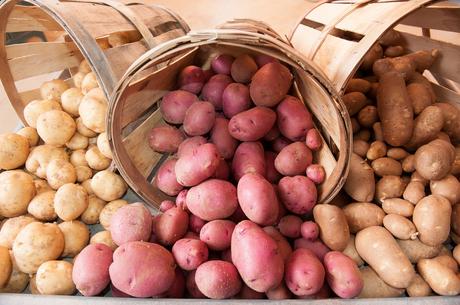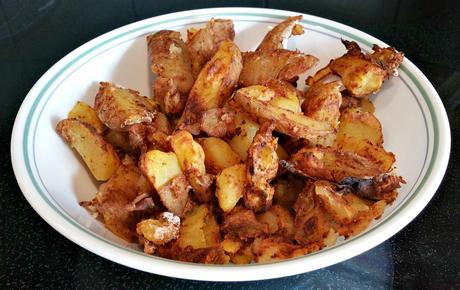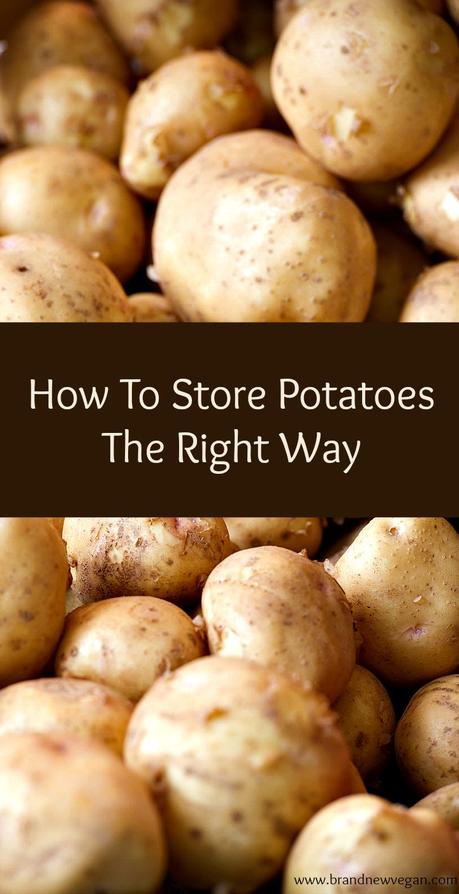I’m sure most of you buy your potatoes at the grocery store, just like I do.
And whether they’re already bagged for quick sale, or you buy them loose and bag them yourself, your choice of bags is usually clear and plastic.
Am I right?
In this new series of How To’s – specifically designed with the Brand New Vegan in mind, I’m going to teach you exactly How to Store Potatoes The Right Way
….. and leaving them in those clear, plastic bags beside your refrigerator is definitely NOT the right way…

Photo by United Soybean Board courtesy of Flickr.
How To Store Potatoes The Right Way
Keep Them Dark
Sure those little plastic bags are handy for carrying your spuds to the checkout counter, but as soon as you get them home you should ditch that plastic bag immediately.
Potatoes need to be stored IN THE DARK.
You’ve seen those green spots that form on your potatoes after a while? That’s from a chemical buildup of something called Solanine. And it’s triggered by light.
Solanine is a glycoalkaloid poison found in species of the nightshade family, such as the potato (Solanum tuberosum) and the tomato (Solanum lycopersicum). Wiki
Not only does it taste really bitter, eating too much of it can make you very sick.
Solanine poisoning is primarily displayed by gastrointestinal and neurological disorders. Symptoms include nausea, diarrhea, vomiting, stomach cramps, burning of the throat, cardiac dysrhythmia, nightmare, headache and dizziness. In more severe cases, hallucinations, loss of sensation, paralysis, fever, jaundice, dilated pupils, hypothermia and death have been reported. Wiki
Yikes! And light causes this!
Now granted – it will probably take munching a LOT of green potatoes to seriously make you sick – but still why take the chance? And remember it won’t take nearly as much for the little ones in your family – so better to be on the safe side.
Ditch those clear, see-thru plastic bags, and store your potatoes the right way. Keep them in the dark. A good place is actually in a paper sack – instead of a plastic bag.
Simply transfer them immediately to a brown paper bag, inspecting your potatoes for any bruising, bad spots, sprouting, or signs of Solanine. And if you do see any green spots forming, cut them off and use the potato immediately, or throw the whole thing away.
Keep Them Cool
We’ve heard the saying “Cool as a Cucumber”, well maybe it should be “Cool as a Potato” because that’s exactly what they need for long-term storage.
A cool, dark spot that is around 40-50 degrees Fahrenheit is perfect for storing potatoes.
Think basement (away from the furnace), garage, root cellar, a cool, dark closet, or maybe even a kitchen cupboard close to the floor.
Although your refrigerator may sound like a good idea, it’s actually too moist, and your spuds will be exposed to too much light for long-term storage – (remember the Solanine!). However if it’s just for a few days – the fridge will do just fine, just be sure and use them up quickly.
Keep Them Dry
Potatoes are normally pretty dirty when you get them home from the store.
And they should be.
Do not wash them until you are ready to use them. Any moisture at all can cause them to spoil. And trust me – that smell is horrendous – especially if you have your potatoes hidden away somewhere and have to hunt around to find the source of the smell!
Nasty.
When you are ready to cook your potatoes, give them a good scrub to remove any loose dirt or eyes, then bake, boil, steam them as normal.
Can’t you just peel your potatoes instead of washing them?
Sure – but you’re throwing away half of the Dietary Fiber of the Potato! But – even if you insist on peeling them anyway – give them a good rinsing before cooking.
Sprouting Spuds
Q. Why do potatoes make good detectives?
A. Because they keep their eyes peeled!
Those little buds you see forming on your potatoes after they’ve been stored for a while are called ‘eyes’ and will eventually sprout. This is the potato’s way of growing a new plant.
When potatoes sprout, the starch in the potatoes is converted into sugar to provide energy for the new plant. (Funny how us humans do the same thing isn’t it? )
If the potato is still firm after the little eyes appear, it has most of the nutrients intact and can be still eaten. Just cut away the sprouted part as use like normal. However, if the potato is shrunken and wrinkled, toss it or plant it.
Do NOT eat the sprouts as they are poisonous with high concentrations of Solanine. And remember the light – Sprouts exposed to light can have two to four times more glycoalkaloids than non exposed sprouts.
Favorite Potato Recipe

Crispy Oven Baked Fat Free French Fry Potatoes
And MY favorite potato recipe?
With over 100,000 page views THIS recipe for Oven Baked French Fry Potatoes steals the show. This was the recipe that got my little blog going and is still everybody’s favorite recipe month after month.
We definitely love our potatoes!
Enjoy



